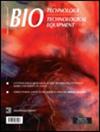猪肺虫胱抑素类似物的生物信息学分析及原核表达
IF 1.4
4区 生物学
Q4 BIOTECHNOLOGY & APPLIED MICROBIOLOGY
引用次数: 0
摘要
胱抑素在寄生虫免疫逃避中起着至关重要的作用。它调节多种免疫反应过程,如抗原呈递、细胞因子和NO的产生以及吞噬作用。近年来,越来越多的寄生虫胱抑素被发现和研究用于治疗炎症性疾病。相比之下,来自羊角螺虫的胱抑素得到的研究关注有限。本研究的目的是利用生物信息学工具和分子生物学技术预测其生物学特性,并从螺旋虫(Spirometra erinaceieuropaei)中获得重组胱抑素类似物。SeCystatin基因由417 bp组成,编码一种大约有100个氨基酸的蛋白质。SeCystatin的预测分子量为10.89 kDa,等电点为6.82;SeCystatin具有12个磷酸化位点和5个翻译后修饰位点,但没有信号肽和跨膜区。SeCystatin的二级结构由1个α-螺旋、4个β-折叠和6个线圈组成。它还具有一个胱抑素特异性保守结构域QxVxG,该结构域位于第一和第二β-折叠之间的边界,从而显示出I型胱抑素的特征。在分子进化的背景下,SeCystatin显示出最高水平的进化相似性。完整合成了SeCystatin基因,构建了重组质粒pET-30a (+)-SeCystatin,在大肠杆菌BL 21中表达目的蛋白。重组SeCystatin通过IPTG诱导表达,通过亲和层析(Ni-IDA)纯化。本研究为进一步研究促生长抑制素的生物学功能奠定了基础。本文章由计算机程序翻译,如有差异,请以英文原文为准。
Bioinformatics analysis and prokaryotic expression of a cystatin analogue from Spirometra erinaceieuropaei
Cystatin plays a crucial role in immune evasion by parasites. It regulates diverse immune response processes, such as antigen presentation, cytokine and NO production, and phagocytosis. In recent years, an increasing number of parasite cystatins have been identified and studied for the treatment of inflammatory diseases. In contrast, cystatin from Spirometra erinaceieuropaei has received limited research attention. The objective of this study was to utilize bioinformatics tools and molecular biology techniques to predict the biological properties and obtain a recombinant cystatin analogue from Spirometra erinaceieuropaei (SeCystatin). The SeCystatin gene consists of 417 bp and encodes a putative 100-amino acid protein. The predicted molecular weight and isoelectric point of SeCystatin were 10.89 kDa and 6.82, respectively; SeCystatin possesses 12 phosphorylation sites and five post-translational modification sites but has no signal peptide and transmembrane region. The secondary structure of SeCystatin consists of one α-helix, four β-folds and six coils. It also possesses a cystatin-specific conserved domain, QxVxG, which is positioned at the boundary between the first and second β-folds, thereby demonstrating the characteristic features of type I cystatin. In the context of molecular evolution, SeCystatin demonstrates the highest level of evolutionary similarity to Schistocephalus solidus. The SeCystatin gene was fully synthesized, and the recombinant plasmid pET-30a (+)-SeCystatin was constructed to express the target protein in Escherichia coli BL 21. Recombinant SeCystatin was successfully induced for expression by IPTG and subsequently purified using affinity chromatography (Ni-IDA). Our study provides a solid foundation for further studies on the biological functions of SeCystatin.
求助全文
通过发布文献求助,成功后即可免费获取论文全文。
去求助
来源期刊

Biotechnology & Biotechnological Equipment
工程技术-生物工程与应用微生物
CiteScore
3.10
自引率
0.00%
发文量
90
审稿时长
1 months
期刊介绍:
Biotechnology & Biotechnological Equipment (B&BE) is an international open access journal publishing cutting-edge research. A modern world requires modern biotechnology and nanobiology. The journal is a forum that provides society with valuable information for a healthy and better life and promotes “the Science and Culture of Nature”.
The journal publishes original research and reviews with a multidisciplinary perspective; expanded case reports with a focus on molecular medical research and advanced practice in evidence-based medicine are also considered.
 求助内容:
求助内容: 应助结果提醒方式:
应助结果提醒方式:


